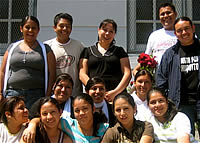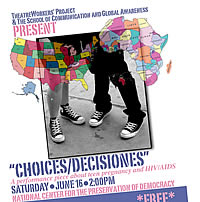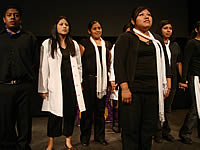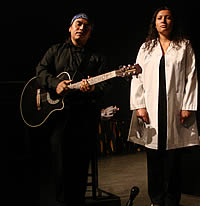For two years, the Los-Angeles based TheatreWorkers’ Project and The School of Communication and Global Awareness at Manual Arts High School, in south Central Los Angeles, have teamed up to create documentary theater written and performed by Manual students. This year’s performance, Choices/Decisiónes—about teen pregnancy and the global AIDS epidemic—played to packed audiences.
As told to WKCD by Susie Tanner, Producing/Artistic Director, TheatreWorkers’ Project:
 “All of the high schools in LAUSD have been mandated to break up into small learning communities. Two years ago, Manual was one of the first high schools to take that step, and one of the small learning communities that resulted was headed by an especially forward-thinking group of teachers. This is the group I’ve worked with, the ‘School of Communication and Global Awareness.’
“All of the high schools in LAUSD have been mandated to break up into small learning communities. Two years ago, Manual was one of the first high schools to take that step, and one of the small learning communities that resulted was headed by an especially forward-thinking group of teachers. This is the group I’ve worked with, the ‘School of Communication and Global Awareness.’
“Last year, the project we did together focused on immigration. With all of the immigration protests that spring, in LA and elsewhere, it couldn’t have been timelier. “This year, the students of SCGA chose health care from a local and global perspective as their theme. The kids who signed up to work with us wanted to do theatre, but also to take their health care studies a step further.
 “In this year’s student group, many of the students were born in either Central America or Mexico. These students are extremely motivated, bright, passionate, poetic. They have strong opinions. They saw the theatre project as a way to share their opinions and beliefs with others.
“In this year’s student group, many of the students were born in either Central America or Mexico. These students are extremely motivated, bright, passionate, poetic. They have strong opinions. They saw the theatre project as a way to share their opinions and beliefs with others.
“Manual is a multi-track school, which in LA means that it operates on multiple sessions, and there are intersessions when the students are ‘off track’ (out of school) for two months at a time. So we decided to conduct the project in the March-April intersession. The class met three times a week for five weeks. About 60 kids signed up and 20 kids showed up and stuck with it. There was an academic teacher with us all the time.
“The teacher provided the introductory information to students, furnishing statistics and facts about the consequences of teen pregnancy and information about AIDS worldwide and most especially in Africa. A health activist and other experts came to speak to the students, including a man who is HIV positive and a woman who is a documentary filmmaker.
 “The teachers and I were a tag team. They would introduce the academic component and then I facilitated the process whereby students drew on this information to create content for their theater pieces. The fact that they would later be acting out what they’d written, rather than creating a script for others to act, made the students consider their written work carefully. We chose a storytelling format and I decided that multiple students would play the same role at different times in the play.
“The teachers and I were a tag team. They would introduce the academic component and then I facilitated the process whereby students drew on this information to create content for their theater pieces. The fact that they would later be acting out what they’d written, rather than creating a script for others to act, made the students consider their written work carefully. We chose a storytelling format and I decided that multiple students would play the same role at different times in the play.
“I began this approach when I worked with unemployed steel workers in the 1980’s. Most documentary theater is performed by actors. In my case, the ‘real’ people, the participants, are the actors.
 “At the end of the five weeks, I took all of the material the students had generated and constructed a first draft of the performance piece. By then, school was back in session and the only time the students and I could work on it was after school. We committed to work together one afternoon a week. There was still lots to do, including editing the script. One of the students wanted to compose original music, too. We began rehearsing in mid-May.
“At the end of the five weeks, I took all of the material the students had generated and constructed a first draft of the performance piece. By then, school was back in session and the only time the students and I could work on it was after school. We committed to work together one afternoon a week. There was still lots to do, including editing the script. One of the students wanted to compose original music, too. We began rehearsing in mid-May.
“I deliberately chose not to have a concrete ending, but rather have the play pose a question to the audience: ‘What would you do if you were in these characters’ shoes?’ An essential component of the performance was a Second Act discussion with the audience where the cast and audience members shared stories, information and offered possible solutions to questions raised by the play. On June 14th and 15th, we performed dress rehearsals for huge groups of Manual students. Finally, on June 16th, we performed in public at The National Center for the Preservation of Democracy in downtown Los Angeles.
“A good percentage of the students at Manual are English Language Learners, so parts of the performance were bilingual. Most of the singing was in Spanish. The post-performance discussion was entirely bilingual. This was also true for the public performance.
One of the most striking aspects of the performance, it turns out, was la ofrenda (‘day of the dead altar’), which the students created at the center of the stage. Students chose different artifacts to decorate the altar. They intermingled artifacts of themselves as teens along with artifacts from Africa. They also created and attached cards with facts about teenage pregnancy and AIDS . As the audience entered the theatre, they filed past the altar to see the artifacts and the cards. Then, just before the show started, the same facts flashed on a screen above the stage. It was very moving.”
Click here to learn more about the project and to read an excerpt from Choices/Decisiónes.
For more information about TheatreWorkers’ Project, please contact twproject@me.com. The project was funded in part by grants from Mentor LA and The Diane Middleton Foundation.


